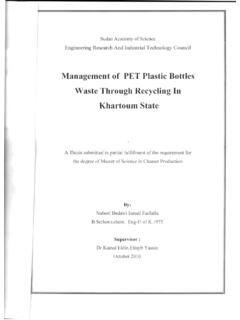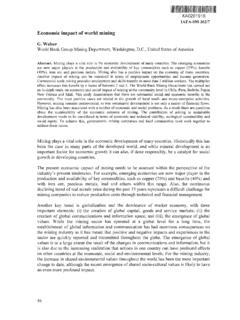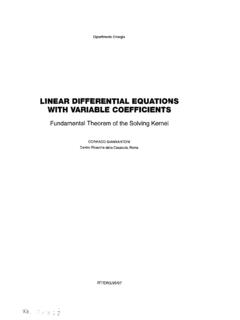Transcription of STORAGE TANKS - SELECTION OF TYPE, DESIGN CODE …
1 B fro0 oofs 2 STORAGE TANKS - SELECTION OF TYPE, DESIGN code AND TANK SIZING Mahmoud N. Shatla and - Mokhtar El Hady Enppi, Cairo, Egypt ABSTRACT The present work gives an insight into the proper SELECTION of type, DESIGN code and sizing of STORAGE TANKS used in the Petroleum and Process industries. In this work, STORAGE TANKS are classified based on their DESIGN conditions. Suitable DESIGN codes and their limitations are discussed for each tank type. The option of STORAGE under high pressure and ambient temperature, in spherical and cigar TANKS , is compared to the option of STORAGE under low temperature and slight pressure (close to ambient) in low temperature and cryogenic TANKS .
2 The discussion is extended to the types of low temperature and cryogenic TANKS and recommendations are given to select their types . A study of pressurized TANKS designed according to asme code , conducted in the present work, reveals that TANKS designed according to asme Section VIII DIV 2 provides cost savings over TANKS designed according to asme Section VIII DIV 1. The present work is extended to discuss the parameters that affect sizing of flat bottom cylindrical TANKS . The analysis shows the effect of height-to-diameter ratio on tank instability and foundation loads TESCE, Vol.
3 30, <g> December 2004 1 INTRODUCTION TANKS are classified based on their DESIGN internal pressure in the volume above the stored product (vapor space). If the DESIGN internal pressure is atmospheric, TANKS are usually designed and constructed according to API 650 code as flat bottom cylindrical TANKS with cone roof. In this case, the maximum allowable internal pressure above the stored product is equal to the weight of the roof plates per unit area ( barg) and the maximum allowable external pressure (vacuum pressure) is barg.
4 If the internal pressure is above barg and below barg, the TANKS can still be designed according to API 650 as flat bottom cylindrical TANKS but taking the provisions of Appendix F, in API 650, into consideration. If the internal DESIGN pressure exceeds barg and is less than barg, TANKS are usually designed as flat bottom cylindrical TANKS with dome roof as per API 620. In this case, the maximum allowable external pressure (vacuum pressure) as per API 620 is barg. Liquids (with vapor pressure > psia) are stored in internal or external floating roof TANKS designed according to API 650 code .
5 When, the DESIGN internal pressure exceeds barg and/or the DESIGN external pressure exceed the API limitations mentioned above, TANKS are designed according to asme code section VIII DIV 1 or DIV 2 as spherical or cigar TANKS . Instead of storing products at high pressure and ambient temperature in cigar or spherical TANKS , products may be stored at low temperature corresponding to their boiling point at slight pressure (close to ambient) in cryogenic TANKS which are more safe and can store larger amounts TESCE, Vol. 30, V___^ December 2004 of products specially liquefied gases.
6 STORAGE in low temperature or cryogenic TANKS requires refrigeration units and is cost effective only when it is required to store large amounts of products such as in liquefied gases export facilities. 2. LOW TEMPERATURE AND CRYOGENIC STORAGE TANKS Flat bottom cylindrical TANKS with dome roof are utilized to store liquefied gases at their boiling point and at a pressure close to atmospheric pressure. The advantages of that STORAGE technique is the safety due to low pressure and the low unit cost of STORAGE due to the large STORAGE capacity.
7 Low temperature STORAGE covers the range from 0 C down to -101 C. The Cryogenic range starts from ~101 C down to -168CC. Some gases are stored in the low temperature range such as NGL (Natural Gas Liquids, its composition is mainly ETHANE+); others are stored in the cryogenic range such as LNG (Liquified Natural Gas, its composition is mainly METHANE & ETHANE). There are many types of flat bottom TANKS that are used to store gases at their boiling points such as the Single Wall Single Containment SWSC (Figure 1), Double Wall Single Containment DWSC (Figure 2), Double Wall Double Containment DWDC (Figure 3) and Full Containment FC TANKS (Figure 4) SWSC tank (Figure 1) consists of shell and bottom mat are made of low temperature steel The shell is covered with a layer of insulation such as polyurethane.
8 Shell insulation is covered with thin metal sheets for weather protection. The shell and bottom rest on load bearing insulation. The shell supports the dome roof plates and structure that are made of regular inexpensive carbon steel because of the utilization of a suspended deck As shown in the Figure, the suspended deck acts as a thermal barrier because oi TLSCE. Vol. 30, 203 December 20(14 the insulation layer that is spread over it. The space above the suspended deck is warm and has superheated vapors of the stored product.)
9 Under the deck, there is a cold vapor space that has saturated vapors of the stored product. The vapors above and below the deck are allowed to circulate through simple open pipe vents that are installed in the deck. The pipe vents help to eliminate any differential pressure across the deck that may cause left on the deck. The suspended deck plates, structure and hangers are made of low temperature material. A concrete ring wall foundation with an interior filled with improved soil may be used if the soil condition is good.
10 In this case, a foundation heating system must be used to prevent the soil from freezing which can result in upheaval and destruction of the brittle bottom insulation. Another type of foundation is the pile type foundation, used in poor soils. In pile type foundation, an elevated pile cap is used to eliminate the need of the tank foundation heating system because the elevated pile cap allows air circulation under the tank which prevents freezing of the soil and its upheaval. Figure 2, shows the DWSC tank. If the outer shell and bottom are made of regular carbon steel and are designed only to protect the insulation, men the tank is DWSC.









